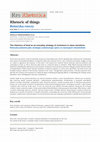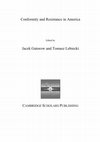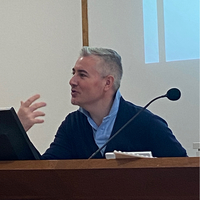Papers by Urszula Niewiadomska-Flis
Pathologizing Black Bodies: The Legacy of Plantation Slavery, 2023
While hip-hop as a form of cultural production has been examined in academia through the prism of... more While hip-hop as a form of cultural production has been examined in academia through the prism of various critical cultural theories, the rhetoric of healthy eating and lifestyle as expressed in hip-hop songs has been virtually absent from scholarly debate. Addressing this lacuna, this chapter analyzes hip-hop songs that expose the pervasive reach of white domination resulting in food and health disparities. Niewiadomska-Flis explores how rappers attempt to reverse contemporary plantation-like politics, which controls African Americans through food apartheid, and how they usher their brothers and sisters along in adopting more health-conscious cuisines.
Pathologizing Black Bodies: The Legacy of Plantation Slavery, 2023
In the book’s final chapter Niewiadomska-Flis examines African Americans’ relations with land and... more In the book’s final chapter Niewiadomska-Flis examines African Americans’ relations with land and agriculture, which have been pathologized through centuries of enslavement, sharecropping, the plantation-to-prison pipeline, and racist federal farm policies. The chapter sets out to explore the ongoing legacy of broken promises, dispossession and systemic racism that affect black land ownership. Natalie Baszile’s novel Queen Sugar (2014) illustrates how this legacy along with “racial capitalism,” affective economies, and the pastoral trope have complicated African Americans’ connection with land and agriculture. The chapter demonstrates that against the odds, black farmers can recover their identities and reconnect with their roots in rural geographies of the contemporary American South.

Res Rhetorica, 2024
Cookbooks are more than mere collections of recipes; they are also repositories of nonculinary in... more Cookbooks are more than mere collections of recipes; they are also repositories of nonculinary information. Those featuring the cuisine of the American South are no exception, reflecting as they do the cultural, historical, and social contexts related to that region's complicated racial history. A prominent part of that history are the Gullah Geechee people-an African American community inhabiting the coastal areas of the Carolinas, Georgia, and northeastern Florida-who have preserved their distinctive cultural heritage in part through the oral transmission of traditional recipes that function as a medium of shared memories that help sustain their communal identity. Recently, these recipes have made their way into print. A notable example is Emily Meggett's bestselling cookbook, Gullah Geechee Home Cooking. In this study, we examine how this venerable matriarch's cookbook creates a rhetorical space facilitating reader engagement with her people's history and culture while simultaneously sharing traditional recipes. In particular, we focus upon how her skillful use of what Gérard Genette calls "paratexts" serves to compliment the main text of her cookbook by offering personal and communal context for such dishes as her famous fried okra. And, we point out how those paratexts situate traditional Gullah Geechee cuisine within the broader culinary conversation of contemporary American food culture.

The Routledge Companion to the Literature of the U.S. South., Jun 13, 2022
Southern hip hop gained national attention in 1995 with OutKast’s Source magazine award win, chal... more Southern hip hop gained national attention in 1995 with OutKast’s Source magazine award win, challenging the East and West Coast dominance. Initially criticized for its regional slang, dance rhythms, and “party-music” style, southern hip hop soon became a major force. Artists like Ludacris, Lil Jon, and Lil Wayne brought southern hip hop to the mainstream, blending regional sounds with themes of racial history, violence, and Black cultural traditions. The South’s diverse soundscape, influenced by genres like blues, jazz, and gospel, showcased the region's musical depth. Miami Bass, New Orleans Bounce, and Houston’s slower, experimental "screwed" sound highlighted the South's unique contributions to hip hop, creating a genre deeply rooted in southern Black experiences.
Atlanta became the epicenter of southern hip hop, rising from Miami-influenced booty music in the 1980s to developing its own distinctive sound in the 1990s with artists like OutKast and Goodie Mob. The city popularized crunk, an energetic, party-oriented subgenre, while also giving birth to trap, snap, and mumble rap. Atlanta’s vibrant music scene fostered collaboration and innovation, with artists mentoring each other and creating new subgenres. This sense of community and constant evolution earned Atlanta its reputation as "hip-hop’s center of gravity," solidifying its importance in shaping modern hip hop.

"Res Rhetorica"
Food is never just food; it is also an instrument of power in a Foucaultian sense. Food is simult... more Food is never just food; it is also an instrument of power in a Foucaultian sense. Food is simultaneously a rhetorical tool of dominance and a means of insubordination/defiance. As depicted within slave narratives food is a site of material and symbolic struggle, serving as a means of oppression and resistance. In this study I will examine how enslaved African Americans used the production and consumption of food, as well as discourse about food, as a rhetorical means of resistance. While Michel Foucault produced the theoretical scaffolding that rethinks power and resistance, his theories can be placed in a productive dialogue with the rhetorical studies of Kenneth Burke, Gillian Symon’s general conception of rhetorical resistance, as well as more specifically with James Scott’s and Elizabeth Janeway’s theories of the everyday resistance of the “weak.” Through these analytical lenses, I will place particular focus upon the role of food in slave narratives as a rhetorical means of de...
“The Gastrodynamics of Edna Pontellier’s liberation.” Transatlantica. Revue d’études américaines.... more “The Gastrodynamics of Edna Pontellier’s liberation.” Transatlantica. Revue d’études américaines. [En ligne], 1: 2011, mis en ligne le 04 janvier 2012. http://transatlantica.revues.org/5307
“Negotiating Gender with a Spatula: Foodways and Gender in Fried Green Tomatoes.” The Americanist... more “Negotiating Gender with a Spatula: Foodways and Gender in Fried Green Tomatoes.” The Americanist 26 (2011): 165-174.
Polish Journal for American Studies 7 (2013): 161-177. http://paas.org.pl/pjas/pjas-archive/

“Ethnic Diaspora Through the Kitchen: Foodways in the Postcolonial Feminist Discourse of Gurinder... more “Ethnic Diaspora Through the Kitchen: Foodways in the Postcolonial Feminist Discourse of Gurinder Chadha’s What’s Cooking?” The Moravian Journal of Literature and Film 4.2 (Fall 2013): 35–53.
In her movie What’s Cooking? (2000), Gurinder Chadha uses foodways as a perfect vehicle for emotional manifestations, attitudes, and dilemmas of four families living in Los Angeles. Chadha incorporates and interweaves various culinary traditions to create an image of multicultural Los Angeles, where members of families belonging to different racial and ethnic minority groups attempt to resist social pressures and preserve their identities and values through their own renditions of Thanksgiving fare. Through the lens of foodways, I want to explore how the movie under analysis employs foodways in presenting cultural heteronormativity, ethnic and racial assimilation, and a single woman’s search for self-definition. Theories of food consumption will furnish an entry point for a discussion of dining rituals in What’s Cooking?, where feasting scenes both represent and subvert gender codes as well as racial, class, and ethnic divisions.

Annales Universitatis Mariae Curie-Sklodowska, sectio FF, Philologia, 2016
From a white woman's kitchen into a black woman's living room: a reconfiguration of the servant/s... more From a white woman's kitchen into a black woman's living room: a reconfiguration of the servant/served paradigm in Ellen Douglas's Can't Quit You, Baby 1 From colonial times, through the Jim Crow era, and up until the Civil Rights movement the domestic kitchen was a battleground in the American South 2. White women attempted to wield their power over first their black slaves and then domestic servants, while black women reciprocated with covert acts of resistance against white domination in the domestic spaces connected with food production and consumption. Doreen Massey posits that "[a] large component of the identity of that place called home derived precisely from the fact that it had always in one way or another been open, constructed out of movement, communication, social relations which always stretched beyond it" 3. Hence, the 1 The present article offers a much extended and revised analysis of Ellen Douglas's novel Can't Quit You, Baby (1989) which I have already briefly carried out in "A Culinary Journey Across the Color Line: Foodways and Race in Southern Literature and Motion Pictures". Unsteadily Marching On: The US South in Motion, ed. C. Gonzáles Groba, Valencia 2013, s. 101-110. Due to the scope of my original research (in "A Culinary Journey…" I also analyzed Fannie Flagg's Fried Green Tomatoes at the Whistle Stop Café, Walker Percy's The Last Gentleman, John Sayles's movie Passion Fish and Driving Miss Daisy directed by Bruce Beresford), Can't Quit You, Baby received a less in-depth evaluation. While the 'nucleus' of the original analysis pertaining to the subject matter at hand is reproduced more or less in verbatim, this paper offers a more thorough explanation and exploration of a recalibration of the servant/served paradigm. 2 The research leading to the publication of this article was funded by the Clifford and Mary Corbridge Trust of Robinson College, the University of Cambridge. In the summertime of 2013 and 2014 I conducted research about "The semiotics of food in the literature of the American South" at the University of Cambridge. 3 D. Massey, A Place Called Home?, "New Formations" 1992, nr 17, s. 14. URSZULA NIEWIADOMSKA-FLIS Katolicki Uniwersytet Lubelski Jana Pawła II Z białej kuchni do czarnego salonu: zmiana relacji służba-pani domu w powieści Ellen Douglas Can't Quit You, Baby
Polish Journal for American Studies
The American South has never been a homogenous concept yet there exists, according to W. J. Cash,... more The American South has never been a homogenous concept yet there exists, according to W. J. Cash, "a profound conviction that the South is another land, sharply differentiated from the rest of the American nation, and exhibiting within itself a remarkable homogeneity" (xlvii). In the 1993 inaugural issue of Southern Cultures

Roczniki Humanistyczne, 2016
The American South's social order, based as it was on white supremacy and subordination of women,... more The American South's social order, based as it was on white supremacy and subordination of women, is reflected in the space of the café in Fannie Flagg's Fried Green Tomatoes at the Whistle Stop Café. The titular café run by two white women, Idgie Threadgoode and Ruth Jamison, becomes a site of contestation of that very social order. In the early 1930s Idgie and Ruth, the main heroines in Flagg's novel, move out of their respective homes into the back of the café, which will offer its services till 1969. Their decision to run a café together has a twofold significance: they reject/transcend domesticity, a socially prescribed space for women, and they act on their increased sensitivity to help the disempowered and oppressed-the black and the poor-during the Jim Crow period. The ownership and management of the café allows Idgie and Ruth to negotiate and redefine their identities in the context of racial oppression and subordination of white women.
in: L'Espace du Sud au féminin. Ed. Brigitte Zaugg and Gérald Préher. Collection “Littérature des... more in: L'Espace du Sud au féminin. Ed. Brigitte Zaugg and Gérald Préher. Collection “Littérature des mondes contemporains, ” Série Amériques, n.7. Metz: Centre "Écritures" de l'Université Paul Verlaine-Metz, 2011. 43-63.

“Storytelling as Rebellion against White Trash Identity in Dorothy Allison’s Trash” Conformity an... more “Storytelling as Rebellion against White Trash Identity in Dorothy Allison’s Trash” Conformity and Resistance in America. Ed. Jacek Gutorow and Tomasz Lebiecki. Newcastle, UK: Cambridge Scholars Publishing, 2007. 347-360.
Dorothy Allison’s concluding sentences from “Preface: Deciding to Live” in Trash reflect her class, race and gender identity and her way of defying the scripted roles she is forced to play: “I write stories. I write fiction. I put on the page a third look at what I’ve seen in life – the condensed and reinvented experience of a cross-eyed working-class lesbian, addicted to violence, language, and hope, who has made the decision to live, is determined to live, on the page and on the street, for me and mine.” Thus, Allison states her intention to find her identity through the act of creative self-expression. As, according to Allison, her work is “not biography and yet not lies,” both her first novel, Bastard out of Carolina, and the collection of short stories, Trash, blur the generic boundaries between fiction and non-fiction by combining the acts of remembering and creating. In so doing they are fictional autobiographies, or, better still, they are the works of an “autobiographer of memory” – a term James Olney uses to describe a writer who utilizes his memories in a “creative sense.” Fiction based on the personal experience of its author releases a creative power which “shapes and reshapes the historic past in the image of the present, making that past as necessary to this present as this present is the inevitable outcome of that past”. In this sense the creative act of storytelling, which is preceded by the act of remembering, has the power to change the past and, at the same time, can influence the writer’s present self-definition.

“An Incestuous Form of Southern Closeness in Peter Taylor’s ‘Venus, Cupid, Folly and Time.’” Comm... more “An Incestuous Form of Southern Closeness in Peter Taylor’s ‘Venus, Cupid, Folly and Time.’” Community and Nearness: Readings in English and American Literature and Culture. Ed. Ilona Dobosiewicz and Jacek Gutorow. Opole: Wydawnictwo Uniwersytetu Opolskiego, 2007. 101-112.
The aim of the present article is to present and analyze the social perspective on the themes and configurations of sibling entanglement in Peter Taylor’s “Venus, Cupid, Folly and Time.” An incest phenomenon in this story, which to some extent may represent the Southern society in general, can be analyzed from multiple perspectives. Firstly, the issue of inbreeding, which was not an unusual phenomenon in the colonial and old South, represented a very closely-knit family as the literal decline of the southern society causing various monstrosities (hereditary illnesses in Poe’s “The Fall of the House of Usher”, or perverse cruelty in McCarthy’s Outer Dark). As in most fictionalized cases of a familial sexual liaison in literature, this insidious relationship leads to decline, if not to fall of the parties concerned. From the second angle, the story can be analyzed as an allegory of a southern flavor for necrophilia. Similarly to Emily Grierson in Faulkner’s “A Rose for Emily,” who was unhealthily reluctant to let the past go, the Dorsets are involved in fabrication of the reality to fit the image of the past. What is more troubling though, is the fact that the townspeople agreed to it in their own futile attempt to be part of the crème de la crème of the society. This social incest thence is the third standpoint. The Dorsets decision to sacrifice everything for each other, rejecting all the suitors, is a more obvious case of social incest, however not more vital, than that of the community. The townspeople’s desire to belong to the circle of the privileged ones, the act which stands in disregard of the traumatic reaction of their children, makes them accessories to incestuous desire to cling to the past.
The incestuous relation between the Dorset siblings as well as the town’s consent of and the desire to revere the past symbolize the attempts to revive the past, the decline of the morals and society in general, as well as the symbolic defiance of the new order.
“The Grotesque Female Body, The Gothic Household and Sexual Politics in Twentieth-century Souther... more “The Grotesque Female Body, The Gothic Household and Sexual Politics in Twentieth-century Southern Short Fiction.” The Body: Readings in English and American Literature and Culture 2. Ed. Ilona Dobosiewicz and Jacek Gutorow. Opole: Wydawnictwo Uniwersytetu Opolskiego, 2009. 101-119.

“Female Friendship and a Narration of Self-Discovery in Twentieth-Century Southern Women’s Writin... more “Female Friendship and a Narration of Self-Discovery in Twentieth-Century Southern Women’s Writing.” British and American Literature and Culture Conference Proceedings. Ed. Piotr Skurowski and Mirosław Aleksander Miernik. Warsaw: English Department of Warsaw University, 2009. 69-83.
It is no coincidence that the American literary scene of the 1970s and 1980s witnessed an outpouring of narrations of self-discovery penned by women writers. Feminist thought has significantly influenced not only the thematic concerns of contemporary novels, but has also helped revitalize and recast the traditional literary genre of the Bildungsroman. Even though literary texts featuring female development were written throughout the nineteenth century (Catherine Sedgwick’s A New England Tale (1822), Augusta Jane Evans’ Beulah (1859) and Louisa May Alcott’s Little Women (1868)), political activism and the sexual revolution of the twentieth century transformed women’s consciousness and literary imagination. In so doing, the contemporary female novel of development entered the uncharted territory of nineteenth-century fiction: the formation of a woman through traveling, education, sexual activities, independent life, and political and social involvement. Southern female fiction, with its emphasis on the inextricably intertwined dimensions of the region, its history, culture, gender, class and race, set out to present these factors as crucial in individual development of female authentic, autonomous selfhood. Such writers as Lisa Alther, Lee Smith, Kaye Gibbons, Bobbie Ann Mason, Alice Walker, Rita Mae Brown and Dori Sanders, to name a few, reformulated the traditional genre of the Bildungsroman to facilitate the presentation of the formation of the female self. Some of them believed female friendship to be vital for the development of a total personality. Hence Gail Godwin in The Odd Woman (1974), Alice Walker in The Color Purple (1982), Kaye Gibbons in Ellen Foster (1987) and Barbara Kingsolver in The Bean Trees (1988) have all depicted women’s bonding as an essential element of a heroine’s journey to self-discovery.
“The Natural and the Artificial: Female Friendship Versus Marriage in the Aristocratic South.” Am... more “The Natural and the Artificial: Female Friendship Versus Marriage in the Aristocratic South.” America: The Natural and the Artificial. Construction of American Identities, Landscapes, Social Institutions and Histories. Magdalena Zapędowska and Paweł Stachura, ed. Seria Filologia Angielska nr. 33. Poznań: Wydawnictwo UAM, 2010. 167-178.
„Zapisy na stole, wywrotowe jedzenie: heteronormatywność i pomidory, Smażone zielone pomidory.” (... more „Zapisy na stole, wywrotowe jedzenie: heteronormatywność i pomidory, Smażone zielone pomidory.” (“Table Inscriptions, subversive foodways: heteronormativity and tomatoes, Fried Green Tomatoes”) Inne Bębny. Różnica i niezgoda w literaturze i kulturze amerykańskiej. [Different Drums: Difference and Dissent in American Literature and Culture] Ed. Izabella Kimak, Ewa Antoszek and Katarzyna Czerwiec-Dykiel. Lublin: Wydawnictwo UMCS, 2013. 28-46.

“A Culinary Journey Across the Color Line: Foodways and Race in Southern Literature and Motion Pi... more “A Culinary Journey Across the Color Line: Foodways and Race in Southern Literature and Motion Pictures.” Unsteadily Marching On: The US South in Motion. Ed. Constante Gonzáles Groba. Biblioteca Javier Coy d’estudis nord-americans. Valencia: Publicacions de la Universitat de València, 2013. 101-110.
If we understand food production and consumption as a socially expressive language (in sociologist Claude Fischler’s words: “Food not only nourishes but also signifies”), then dining and cooking rituals can be read as tropes signifying social structure as well as racial relations of a given community. Dining rituals become a vehicle of acceptance or rejection of people’s social identities imposed by a given society. Roland Barthes’ suggestion that food signifies society’s deepest values finds confirmation in the fact that often in Southern “texts,” such as Driving Miss Daisy, Passion Fish, Fried Green Tomatoes, Can’t Quit you Baby, and Ellen Foster, racial relations are often expressed in culinary terms.
As representations of food in fiction and motion pictures are never conjectural, I will attempt to illustrate how we can theorize race through foodways in Southern literature and cinematography. In my research I will analyze how Southern “texts” endow food-related activities with subversive characteristics (I will be interested in both the continuity and the change in social restrictions of race) and how the kitchen and dining room may assist Southerners on their quest to assert their racial identity.











Uploads
Papers by Urszula Niewiadomska-Flis
Atlanta became the epicenter of southern hip hop, rising from Miami-influenced booty music in the 1980s to developing its own distinctive sound in the 1990s with artists like OutKast and Goodie Mob. The city popularized crunk, an energetic, party-oriented subgenre, while also giving birth to trap, snap, and mumble rap. Atlanta’s vibrant music scene fostered collaboration and innovation, with artists mentoring each other and creating new subgenres. This sense of community and constant evolution earned Atlanta its reputation as "hip-hop’s center of gravity," solidifying its importance in shaping modern hip hop.
In her movie What’s Cooking? (2000), Gurinder Chadha uses foodways as a perfect vehicle for emotional manifestations, attitudes, and dilemmas of four families living in Los Angeles. Chadha incorporates and interweaves various culinary traditions to create an image of multicultural Los Angeles, where members of families belonging to different racial and ethnic minority groups attempt to resist social pressures and preserve their identities and values through their own renditions of Thanksgiving fare. Through the lens of foodways, I want to explore how the movie under analysis employs foodways in presenting cultural heteronormativity, ethnic and racial assimilation, and a single woman’s search for self-definition. Theories of food consumption will furnish an entry point for a discussion of dining rituals in What’s Cooking?, where feasting scenes both represent and subvert gender codes as well as racial, class, and ethnic divisions.
Dorothy Allison’s concluding sentences from “Preface: Deciding to Live” in Trash reflect her class, race and gender identity and her way of defying the scripted roles she is forced to play: “I write stories. I write fiction. I put on the page a third look at what I’ve seen in life – the condensed and reinvented experience of a cross-eyed working-class lesbian, addicted to violence, language, and hope, who has made the decision to live, is determined to live, on the page and on the street, for me and mine.” Thus, Allison states her intention to find her identity through the act of creative self-expression. As, according to Allison, her work is “not biography and yet not lies,” both her first novel, Bastard out of Carolina, and the collection of short stories, Trash, blur the generic boundaries between fiction and non-fiction by combining the acts of remembering and creating. In so doing they are fictional autobiographies, or, better still, they are the works of an “autobiographer of memory” – a term James Olney uses to describe a writer who utilizes his memories in a “creative sense.” Fiction based on the personal experience of its author releases a creative power which “shapes and reshapes the historic past in the image of the present, making that past as necessary to this present as this present is the inevitable outcome of that past”. In this sense the creative act of storytelling, which is preceded by the act of remembering, has the power to change the past and, at the same time, can influence the writer’s present self-definition.
The aim of the present article is to present and analyze the social perspective on the themes and configurations of sibling entanglement in Peter Taylor’s “Venus, Cupid, Folly and Time.” An incest phenomenon in this story, which to some extent may represent the Southern society in general, can be analyzed from multiple perspectives. Firstly, the issue of inbreeding, which was not an unusual phenomenon in the colonial and old South, represented a very closely-knit family as the literal decline of the southern society causing various monstrosities (hereditary illnesses in Poe’s “The Fall of the House of Usher”, or perverse cruelty in McCarthy’s Outer Dark). As in most fictionalized cases of a familial sexual liaison in literature, this insidious relationship leads to decline, if not to fall of the parties concerned. From the second angle, the story can be analyzed as an allegory of a southern flavor for necrophilia. Similarly to Emily Grierson in Faulkner’s “A Rose for Emily,” who was unhealthily reluctant to let the past go, the Dorsets are involved in fabrication of the reality to fit the image of the past. What is more troubling though, is the fact that the townspeople agreed to it in their own futile attempt to be part of the crème de la crème of the society. This social incest thence is the third standpoint. The Dorsets decision to sacrifice everything for each other, rejecting all the suitors, is a more obvious case of social incest, however not more vital, than that of the community. The townspeople’s desire to belong to the circle of the privileged ones, the act which stands in disregard of the traumatic reaction of their children, makes them accessories to incestuous desire to cling to the past.
The incestuous relation between the Dorset siblings as well as the town’s consent of and the desire to revere the past symbolize the attempts to revive the past, the decline of the morals and society in general, as well as the symbolic defiance of the new order.
It is no coincidence that the American literary scene of the 1970s and 1980s witnessed an outpouring of narrations of self-discovery penned by women writers. Feminist thought has significantly influenced not only the thematic concerns of contemporary novels, but has also helped revitalize and recast the traditional literary genre of the Bildungsroman. Even though literary texts featuring female development were written throughout the nineteenth century (Catherine Sedgwick’s A New England Tale (1822), Augusta Jane Evans’ Beulah (1859) and Louisa May Alcott’s Little Women (1868)), political activism and the sexual revolution of the twentieth century transformed women’s consciousness and literary imagination. In so doing, the contemporary female novel of development entered the uncharted territory of nineteenth-century fiction: the formation of a woman through traveling, education, sexual activities, independent life, and political and social involvement. Southern female fiction, with its emphasis on the inextricably intertwined dimensions of the region, its history, culture, gender, class and race, set out to present these factors as crucial in individual development of female authentic, autonomous selfhood. Such writers as Lisa Alther, Lee Smith, Kaye Gibbons, Bobbie Ann Mason, Alice Walker, Rita Mae Brown and Dori Sanders, to name a few, reformulated the traditional genre of the Bildungsroman to facilitate the presentation of the formation of the female self. Some of them believed female friendship to be vital for the development of a total personality. Hence Gail Godwin in The Odd Woman (1974), Alice Walker in The Color Purple (1982), Kaye Gibbons in Ellen Foster (1987) and Barbara Kingsolver in The Bean Trees (1988) have all depicted women’s bonding as an essential element of a heroine’s journey to self-discovery.
If we understand food production and consumption as a socially expressive language (in sociologist Claude Fischler’s words: “Food not only nourishes but also signifies”), then dining and cooking rituals can be read as tropes signifying social structure as well as racial relations of a given community. Dining rituals become a vehicle of acceptance or rejection of people’s social identities imposed by a given society. Roland Barthes’ suggestion that food signifies society’s deepest values finds confirmation in the fact that often in Southern “texts,” such as Driving Miss Daisy, Passion Fish, Fried Green Tomatoes, Can’t Quit you Baby, and Ellen Foster, racial relations are often expressed in culinary terms.
As representations of food in fiction and motion pictures are never conjectural, I will attempt to illustrate how we can theorize race through foodways in Southern literature and cinematography. In my research I will analyze how Southern “texts” endow food-related activities with subversive characteristics (I will be interested in both the continuity and the change in social restrictions of race) and how the kitchen and dining room may assist Southerners on their quest to assert their racial identity.
Atlanta became the epicenter of southern hip hop, rising from Miami-influenced booty music in the 1980s to developing its own distinctive sound in the 1990s with artists like OutKast and Goodie Mob. The city popularized crunk, an energetic, party-oriented subgenre, while also giving birth to trap, snap, and mumble rap. Atlanta’s vibrant music scene fostered collaboration and innovation, with artists mentoring each other and creating new subgenres. This sense of community and constant evolution earned Atlanta its reputation as "hip-hop’s center of gravity," solidifying its importance in shaping modern hip hop.
In her movie What’s Cooking? (2000), Gurinder Chadha uses foodways as a perfect vehicle for emotional manifestations, attitudes, and dilemmas of four families living in Los Angeles. Chadha incorporates and interweaves various culinary traditions to create an image of multicultural Los Angeles, where members of families belonging to different racial and ethnic minority groups attempt to resist social pressures and preserve their identities and values through their own renditions of Thanksgiving fare. Through the lens of foodways, I want to explore how the movie under analysis employs foodways in presenting cultural heteronormativity, ethnic and racial assimilation, and a single woman’s search for self-definition. Theories of food consumption will furnish an entry point for a discussion of dining rituals in What’s Cooking?, where feasting scenes both represent and subvert gender codes as well as racial, class, and ethnic divisions.
Dorothy Allison’s concluding sentences from “Preface: Deciding to Live” in Trash reflect her class, race and gender identity and her way of defying the scripted roles she is forced to play: “I write stories. I write fiction. I put on the page a third look at what I’ve seen in life – the condensed and reinvented experience of a cross-eyed working-class lesbian, addicted to violence, language, and hope, who has made the decision to live, is determined to live, on the page and on the street, for me and mine.” Thus, Allison states her intention to find her identity through the act of creative self-expression. As, according to Allison, her work is “not biography and yet not lies,” both her first novel, Bastard out of Carolina, and the collection of short stories, Trash, blur the generic boundaries between fiction and non-fiction by combining the acts of remembering and creating. In so doing they are fictional autobiographies, or, better still, they are the works of an “autobiographer of memory” – a term James Olney uses to describe a writer who utilizes his memories in a “creative sense.” Fiction based on the personal experience of its author releases a creative power which “shapes and reshapes the historic past in the image of the present, making that past as necessary to this present as this present is the inevitable outcome of that past”. In this sense the creative act of storytelling, which is preceded by the act of remembering, has the power to change the past and, at the same time, can influence the writer’s present self-definition.
The aim of the present article is to present and analyze the social perspective on the themes and configurations of sibling entanglement in Peter Taylor’s “Venus, Cupid, Folly and Time.” An incest phenomenon in this story, which to some extent may represent the Southern society in general, can be analyzed from multiple perspectives. Firstly, the issue of inbreeding, which was not an unusual phenomenon in the colonial and old South, represented a very closely-knit family as the literal decline of the southern society causing various monstrosities (hereditary illnesses in Poe’s “The Fall of the House of Usher”, or perverse cruelty in McCarthy’s Outer Dark). As in most fictionalized cases of a familial sexual liaison in literature, this insidious relationship leads to decline, if not to fall of the parties concerned. From the second angle, the story can be analyzed as an allegory of a southern flavor for necrophilia. Similarly to Emily Grierson in Faulkner’s “A Rose for Emily,” who was unhealthily reluctant to let the past go, the Dorsets are involved in fabrication of the reality to fit the image of the past. What is more troubling though, is the fact that the townspeople agreed to it in their own futile attempt to be part of the crème de la crème of the society. This social incest thence is the third standpoint. The Dorsets decision to sacrifice everything for each other, rejecting all the suitors, is a more obvious case of social incest, however not more vital, than that of the community. The townspeople’s desire to belong to the circle of the privileged ones, the act which stands in disregard of the traumatic reaction of their children, makes them accessories to incestuous desire to cling to the past.
The incestuous relation between the Dorset siblings as well as the town’s consent of and the desire to revere the past symbolize the attempts to revive the past, the decline of the morals and society in general, as well as the symbolic defiance of the new order.
It is no coincidence that the American literary scene of the 1970s and 1980s witnessed an outpouring of narrations of self-discovery penned by women writers. Feminist thought has significantly influenced not only the thematic concerns of contemporary novels, but has also helped revitalize and recast the traditional literary genre of the Bildungsroman. Even though literary texts featuring female development were written throughout the nineteenth century (Catherine Sedgwick’s A New England Tale (1822), Augusta Jane Evans’ Beulah (1859) and Louisa May Alcott’s Little Women (1868)), political activism and the sexual revolution of the twentieth century transformed women’s consciousness and literary imagination. In so doing, the contemporary female novel of development entered the uncharted territory of nineteenth-century fiction: the formation of a woman through traveling, education, sexual activities, independent life, and political and social involvement. Southern female fiction, with its emphasis on the inextricably intertwined dimensions of the region, its history, culture, gender, class and race, set out to present these factors as crucial in individual development of female authentic, autonomous selfhood. Such writers as Lisa Alther, Lee Smith, Kaye Gibbons, Bobbie Ann Mason, Alice Walker, Rita Mae Brown and Dori Sanders, to name a few, reformulated the traditional genre of the Bildungsroman to facilitate the presentation of the formation of the female self. Some of them believed female friendship to be vital for the development of a total personality. Hence Gail Godwin in The Odd Woman (1974), Alice Walker in The Color Purple (1982), Kaye Gibbons in Ellen Foster (1987) and Barbara Kingsolver in The Bean Trees (1988) have all depicted women’s bonding as an essential element of a heroine’s journey to self-discovery.
If we understand food production and consumption as a socially expressive language (in sociologist Claude Fischler’s words: “Food not only nourishes but also signifies”), then dining and cooking rituals can be read as tropes signifying social structure as well as racial relations of a given community. Dining rituals become a vehicle of acceptance or rejection of people’s social identities imposed by a given society. Roland Barthes’ suggestion that food signifies society’s deepest values finds confirmation in the fact that often in Southern “texts,” such as Driving Miss Daisy, Passion Fish, Fried Green Tomatoes, Can’t Quit you Baby, and Ellen Foster, racial relations are often expressed in culinary terms.
As representations of food in fiction and motion pictures are never conjectural, I will attempt to illustrate how we can theorize race through foodways in Southern literature and cinematography. In my research I will analyze how Southern “texts” endow food-related activities with subversive characteristics (I will be interested in both the continuity and the change in social restrictions of race) and how the kitchen and dining room may assist Southerners on their quest to assert their racial identity.
ISBN: 978-84-370-8866-2
With The Southern Mystique I want to add a modest voice to the debate about how womanhood is constructed and negotiated in Southern fiction and films. I wish to interrogate the “material effects” of Southern myths (Baym, Feminism and American Literary History) on constructions and negotiations of Southern womanhood against the white, male, heterosexist normativity of Southern culture. Patricia Yaeger’s observation that Southern literature is not about a coherent identity or a shared community “but about moments of crisis and acts of contestation, about the intersection of black and white cultures as they influence one another and collide” (Dirt and Desire) may as well be applicable to a discussion of Southern constructions of gender. The Southern Mystique is about those moments of crisis and collisions in gender relations in Southern society.
The essays collected in this book continue the now-established trends of the Southern theoretical scholarship toward gender-construction. This book makes use of feminist literary criticism, reinterpretation of psychoanalytic theory, theories of space, subject formation, grotesque, and carnival to reconsider constructing Southern gender as presented in the twentieth-century fiction and movies. Three conceptual issues have guided the present research project. Firstly, Southern women can work within and against their society’s discourses of gender through culinary practices. Secondly, through the agency of female friendship women can transgress their “place” prescribed by patriarchy. Thirdly, in order to command gender construction women have to challenge patriarchal protection of the feminine and defy the rules of confinement of femininity in the domestic space.
Amb la intenció de reconsiderar la construcció meridional del gènere que es mostra en la ficció i en les pel.lícules del segle XX naix aquest volum. Tres aspectes conceptuals guien la investigació. En primer lloc, les dones del sud poden treballar des de i en contra dels discursos de gènere de la seua societat a través de les pràctiques culinàries. En segon lloc, a través de l'amistat femenina, les dones poden transgredir el seu lloc prescrit pel patriarcat. En tercer lloc, per a infondre la construcció de gènere les dones han de desafiar la protecció patriarcal i desobeir les regles de confinament de la feminitat en l'espai domèstic. Així, aquest volum qüestiona els efectes materials dels mites meridionals sobre les construccions i les negociacions de la condició de dona meridional contra les normes blanques, masculines i heterosexistes de la cultura del sud.
Rev. of Karen L. Cox, ed. Destination Dixie: Tourism & Southern History. European Journal of American Studies [Online], Reviews 2013-2, document 5, Online since 30 July 2013,